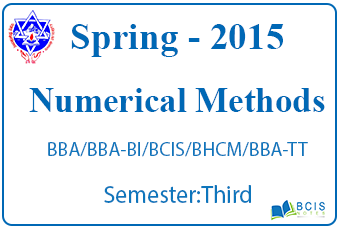
| Level: Bachelor | Semester –Spring | Year: 2015 |
| Program: BCIS | Full Marks: 100 | |
| Course: Numerical Methods | Pass Marks: 45 | |
| Time: 3hrs. | ||
| Candidates are required to give their answers in their own words as far as practicable. |
| The figures in the margin indicate full marks. |
| Section “A”
Very Short Answer Questions Attempt all the questions. |
10×2 |
|||||||||||||||
| 1. | Define absolute and relative error. | |||||||||||||||
| 2. | Find the root interval of the equation x2 – 4x -10. | |||||||||||||||
| 3. | State the iterative formula for the false position method to solve f(x)=0. | |||||||||||||||
| 4. | What is the main difference between Gauss elimination and Gauss Jordan method? | |||||||||||||||
| 5. | What is the necessary condition for the solution of a system of linear equations and what are the possible solutions? | |||||||||||||||
| 6. | What are the methods available for interpolations? | |||||||||||||||
| 7. | Write first-order forward difference formula. | |||||||||||||||
| 8. | Numerical integration with a number of interval n=3 and n=6 which one is more accurate and why? | |||||||||||||||
| 9. | Find the normalized regression equation for the transcendental form y=ABx. | |||||||||||||||
| 10. | What are Poisson’s Equations? | |||||||||||||||
| Section “B”
Descriptive Answer Questions Attempt any six questions |
6×10 |
|||||||||||||||
| 11. | Using False Position method, solve the equation xtan(x) = -1 starting with initial guess 2.5 and 3 correct up to 3- decimal places. | |||||||||||||||
| 12. | Solve the following system of linear equations using the Gauss elimination method with partial pivoting. | |||||||||||||||
| 13. | Growth of bacteria (N) in culture after t hrs. is given by
Fit a curve of the form N= abt and estimate bacteria when t=5 hrs. |
|
||||||||||||||
| 14. | Integrate the given integral.
Using the Trapezoidal rule + Simpson’s rule with n=4 and n=6, compare your result and comment on it. |
|||||||||||||||
| 15. | Solve the equations y’= + with x=0.25 and x=0.5 given that y(0)=1
a) Using Eulers Method (h=0.25) b) By using Runge Kutta method 4th order (h=0.25) |
|||||||||||||||
| 16. | Solve the equation T=2 over the square domain with sides x=0=y, x=3=y with T=0 on the boundary, and mesh length=1 using the Gauss-Seidel method. | |||||||||||||||
| 17. | Using Newton’s divided difference formula:
a) Evaluate f(8). b) Evaluate f(15) of the above-given values in the table. |
|
||||||||||||||
|
18. |
Section “C”
Case Analysis Mr. Ram has invested a sum of Rs 20,000 in three types of fixed deposits with an interest rate of 10%, 11%, and 12%. He earns an annual interest of Rs 2,220 from all three types of deposits. If some of the amounts with 11% and 12% interest rates are four times the amount earning 10% interest. a) Formulate the appropriate system of linear equations to determine the amount invested in each type.[5] b) Compute the amount invested in each type.[7] c) Write a program to determine the amount invested in each category of interest.[8] |
20 |
You may also like: Computer Architecture and Microprocessors || Fall 2017 || Pokhara University

Leave a Reply